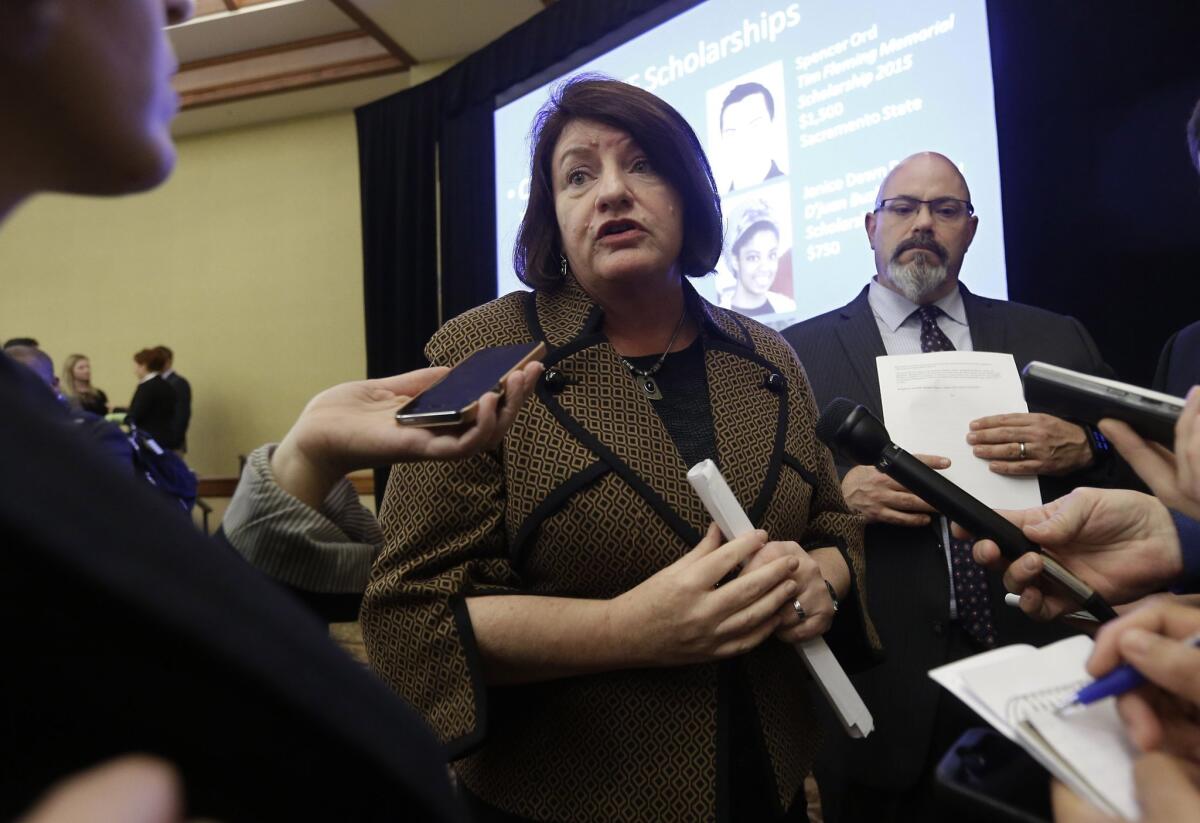California lawmakers break from Newsom’s budget, extend deadline for federal cash

- Share via
SACRAMENTO — California Senate Democrats are poised to reject $14 billion in budget cuts proposed by Gov. Gavin Newsom earlier this month, choosing instead to craft a spending plan that looks for other ways to erase the state’s deficit and assumes additional money for schools and social services will come from the federal government by early September.
The proposal relies on an alternate approach to Newsom’s plea for additional funds from President Trump and Congress, said legislative sources who asked not to be identified because they weren’t authorized to discuss the document. It also proposes some different cuts than those in Newsom‘s plan, refusing some of the governor’s cuts to child care provider rates and affordable housing programs.
A spokeswoman for Senate President Pro Tem Toni Atkins (D-San Diego) declined to comment on the budget proposal Wednesday. The budget plan is expected to be formally ratified by the Senate Budget Committee on Thursday.
Newsom wants $14 billion in immediate spending cuts — including $8.1 billion less for public schools — that would be rescinded only if federal cash is sent to California. In contrast, Senate Democrats will insist the budget be scaled back only if sufficient federal assistance doesn’t arrive by Sept. 1.
The legislative plan “avoids harm to schools and other programs by not implementing harsh cuts that may prove to not be necessary,” states an internal Senate document obtained by The Times.
The Senate plan lays out $13 billion in budget solutions if assistance from Washington doesn’t materialize. That includes additional use of cash reserves, internal borrowing and a more limited list of cuts. The plan also opts to delay, not cut, some $5.3 billion in school spending should the state not receive the assistance and would scale back Newsom’s proposed cuts to the University of California and California State University systems.
Senate Democrats will also call for the restoration of a widely panned budget-balancing maneuver from the Great Recession: a one day shift, from the last day of June to the first day of July, for paying state government employees. That shifts the cost of those paychecks into a new fiscal year, thus being counted as a short-term spending cut.
In essence, the two approaches differ as to how much optimism about political compromise in Washington should be taken into account in California’s beleaguered budget. Senate Democrats believe some of the most drastic remedies offered by Newsom may not be necessary. A document drafted by legislative staff members earlier this month and reviewed by The Times envisions at least $33 billion in federal funds between now and the early summer of 2022.
That level of federal help could stave off some of the deepest reductions in core government services, otherwise necessary in light of the swift decline in tax revenues brought on by what some analysts already are calling a pandemic-induced recession.
Another key difference in budget approaches is the projected growth in California’s government healthcare service, Medi-Cal, and its welfare assistance program, CalWorks. The Senate will adopt projections by the independent Legislative Analyst’s Office of less growth in the number of people who will qualify for either aid program than assumed by Newsom’s budget team, reducing spending by $3.6 billion.
Newsom’s budget, crafted to erase a projected $54.3-billion shortfall stretching through July of next year, calls for a variety of belt-tightening efforts but is largely built on cuts totaling more than $25 billion.
It’s unclear whether Democrats in the state Assembly will embrace the plan. A spokeswoman for Assembly Speaker Anthony Rendon (D-Lakewood) said Wednesday that members of the lower house will carefully review the plan. On Tuesday, Assembly members roundly criticized Newsom’s deep budget cuts during a special meeting on the state’s budget crisis. But few proposals for avoiding those cuts were discussed, other than limited ways to increase tax revenues.
The approach by Senate Democrats to link deep budget cuts to the outcome of future events borrows a page from the playbook of former Gov. Jerry Brown. His budget plan in the summer of 2012 assumed $6 billion in revenues from a tax increase California voters would consider that November, Proposition 30. Had voters rejected the tax measure (they did not), the budget would have automatically triggered the spending cuts, most of which would have been made to K-12 schools.
Lawmakers have had less time to consider the state budget than they traditionally would, with both houses suspending operations for seven weeks due to public health concerns. By law, they must send Newsom a balanced budget by June 15, though they can update or modify that budget in the summer, based on new economic data.
More to Read
Sign up for Essential California
The most important California stories and recommendations in your inbox every morning.
You may occasionally receive promotional content from the Los Angeles Times.











